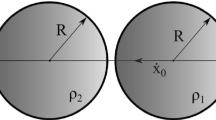Abstract
Understanding the mechanisms of hard-soft material interaction under impact loading is important not only in the defense industry but also in daily life. However, traditional mesh-based spatial discretization methods that are time consuming owing to the need for frequent re-meshing, such as the finite element method and finite difference method, can hardly handle large deformation involving failure evolution in a multi-phase interaction environment. The objective of this research is to develop a quasi-meshless particle method based on the material point method for the model-based simulation of the hard-soft material interaction response. To demonstrate the proposed procedure, scenarios of a hard-soft material impact test are considered, where a force is applied to layers of materials and a hard bar with an initial velocity impacts a target with layers of different materials. The stress wave propagation and resulting failure evolution are simulated and compared with available data. Future research tasks are then discussed on the basis of the preliminary results.
Similar content being viewed by others
References
Ke H B, Liu C T, Yang Y. Structural heterogeneity and deformation rheology in metallic glasses. Sci China Tech Sci, 2015, 58: 47–55
Chen Z, Jiang S, Gan Y, et al. A particle-based multiscale simulation procedure within the material point method framework. Comput Part Mech, 2014, 1: 147–158
Zhu D. Z, Ma G J, Wu C W, et al. Numerical study of the impact response of woodpecker’s head. AIP Adv, 2012, 2: 042173
Sepehri B, Omidian S. Numerical model of the human head under side impact. J Basic Appl Sci Res, 2013, 3: 470–474
Roberts J C, O’Conner J V, Ward E E. Modeling the effect of non-penetrating ballistic impact as a means of detecting behind armor blunt trauma. J Trauma, 2005, 58: 1241–1251
Chen Z, Han Y L, Jiang S, et al. A multiscale material point method for impact simulation. TAML, 2012, 2: 051003
Zhang Z, Wang J F, Cheng Y M, et al. The improved element-free Galerkin method for three-dimensional transient heat conduction problems. Sci China Phys Mech Astron, 2013, 56: 1568–1580
Liu G R, Liu M B. Smoothed Particle Hydrodynamics-A Meshfree Particle Method. Singapore: World Scientific, 2003. 1–10
Sulsky D, Chen Z, Schreyer H L. A particle method for history-dependent materials. Comput Method Appl M, 1994, 118: 179–196
Brackbill J U, Ruppel H M. FLIP: A method for adaptively zoned, particle-in-cell calculations of fluid flows in two dimensions. J Comput Phys, 1986, 65: 314–343
Harlow F H. The particle-in-cell computing method for fluid dynamics. Method Comput Phys, 1964, 3: 319–343
York I I A R, Sulsky D, Schreyer H L. The material point method for simulation of thin membranes. Int J Numer Meth Eng, 1999, 44: 1429–1456
Zhang X, Liu Y, Ma S. Meshfree methods and their applications. Adv Mech, 2009, 39: 1–36
Ambati R, Pan X F, Yuan H. Application of material point method for cutting process simulation. Comp Mater Sci, 2012, 57: 102–110
Chen Z, Hu W, Shen L, et al. An evaluation of the MPM for simulation dynamic failure with damage diffusion. Eng Fract Mech, 2002, 69: 1873–1890
Lawrence Livermore National Laboratory. 2014-9-10. https://wci.llnl.gov/codes/visit
Author information
Authors and Affiliations
Corresponding author
Rights and permissions
About this article
Cite this article
Liu, H., Jiang, S., Chen, Z. et al. Simulation of hard-soft material interaction under impact loading employing the material point method. Sci. China Technol. Sci. 58, 763–768 (2015). https://doi.org/10.1007/s11431-015-5780-9
Received:
Accepted:
Published:
Issue Date:
DOI: https://doi.org/10.1007/s11431-015-5780-9




